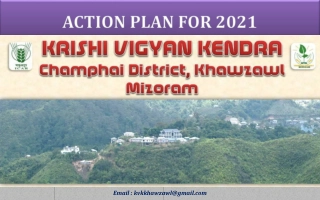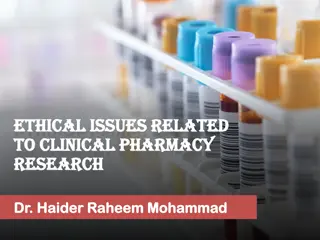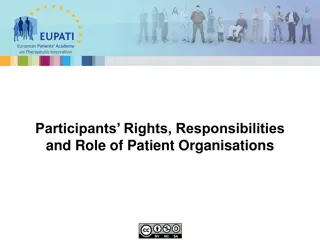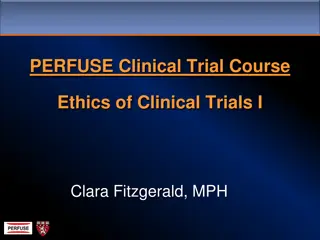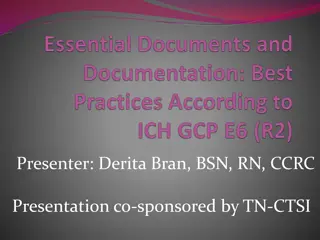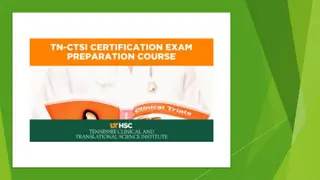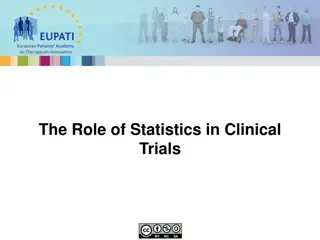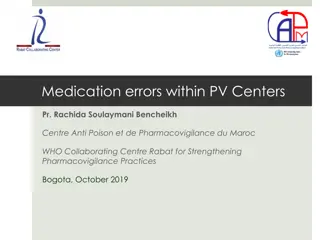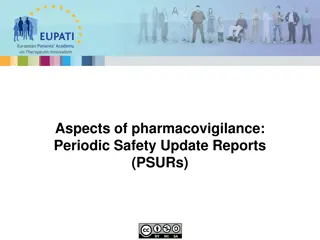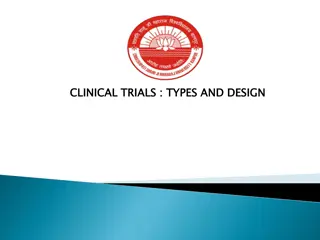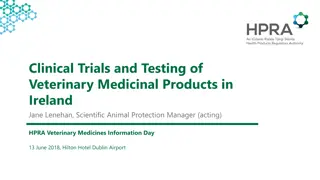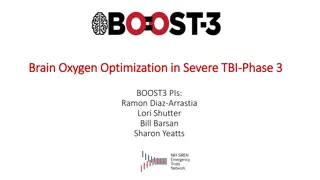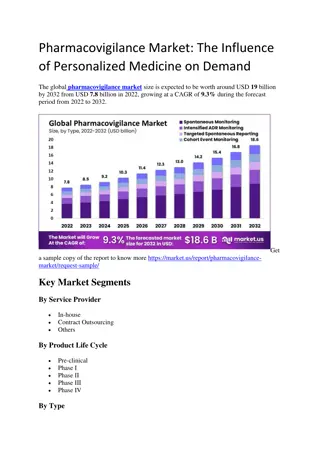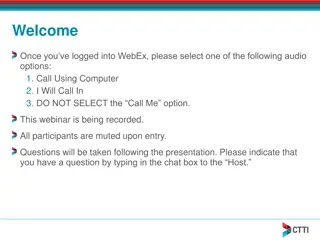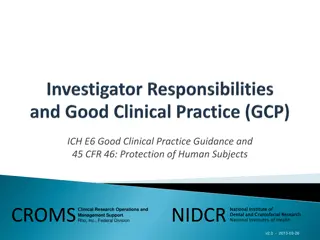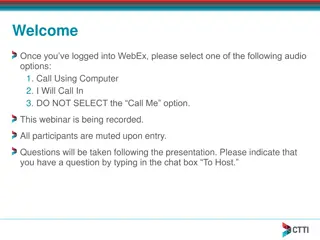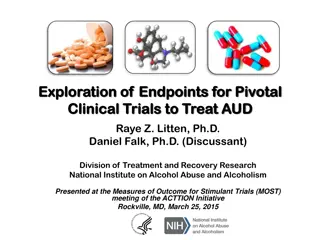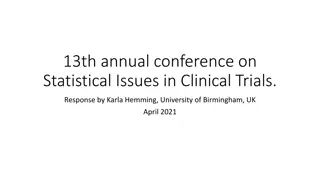
Evolution of Drug Safety Regulations: A Historical Perspective
Explore the history of drug safety regulations, from the tragic incidents in the 19th century to the establishment of stringent measures in the 20th century. Discover key milestones, such as the Thalidomide tragedy, the introduction of the Kefauver-Harris amendment, and the implications of drug withdrawals in recent years. Understand the continuous efforts to enhance drug safety and protect public health.
Download Presentation

Please find below an Image/Link to download the presentation.
The content on the website is provided AS IS for your information and personal use only. It may not be sold, licensed, or shared on other websites without obtaining consent from the author. If you encounter any issues during the download, it is possible that the publisher has removed the file from their server.
You are allowed to download the files provided on this website for personal or commercial use, subject to the condition that they are used lawfully. All files are the property of their respective owners.
The content on the website is provided AS IS for your information and personal use only. It may not be sold, licensed, or shared on other websites without obtaining consent from the author.
E N D
Presentation Transcript
2 History of Drug Safety - I 1848 15 year old Hannah Greener died in course of routine anaesthesia with chloroform (problem: ingrown nail of toe; fibrillation of ventricles?). 1893 - Lancet initiated foundation of a commission and starting collection of notifications about side effects 1906 - US Federal Food and Drug Act - required, that the pharmaceuticals should be pure and free of any contamination (nothing about the efficacy) 1936 - USA-s 107 lethal cases after sulphanilamides (diethylene glycol was used to solubilize); 1938 - Food, Drug, and CosmeticAct, 1938. Firms had to prove to FDAthat any new drug was safe before it could be marketed: the birth of the new drug application. Katalyst Healthcares & Life Sciences 12/10.16
3 History of Drug Safety - II 1961 - Dr William McBride (Australia) reported 20% increase in foetal abnormalities and phocomelia in relation with thalidomide use, later numerous reports from other countries (more than 4000 cases) 1962 - USAKefauver-Harris amendment to the law (requirement to prove safety and efficacy before issuing MA) 1963 - resolution WHA16.36 reaffirmed the need for early action in regard to adverse drug reactions 1964 - UK started yellow cards system 1965 - European Union issued EC Directive 65/65 - first European pharmaceutical directive. The directive was a reaction to the Thalidomide tragedy in the early 1960s, and aimed to establish and maintain a high level of protection for public health in Europe. 1968 - start of WHO Programme for International Drug Monitoring 1990 - ICH - elaboration of intra-regional requirements for safety starts. ICH Safety Guidelines Katalyst Healthcares & Life Sciences 12/10.16
4 Are Drugs Safer Today? During 1960-1999 there were 121 safety related withdrawals Worldwide Market life less than 2 years 31% Market life less than 5 years 50% Fung et al. Drug Information Journal, 2001; 35:293-317 During 1972-1994 in 583 new active substances were approved Of these 59 were withdrawn later Katalyst Healthcares & Life Sciences 12/10.16
5 Recent Drug Withdrawals Drugs withdrawn from market due to Safety Issues Terfenadine (Seldane) 1998 Withdrawn due to risk of cardiac arrhythmias; Mibefradil (Posicor) 1998 Withdrawn due to dangerous interactions with other drugs Trovafloxacin (Trovan) 1998-1999 Withdrawn due to risk of liver failure Withdrawn due to risk of hepatotoxicity; superseded by pioglitazone and rosiglitazone Troglitazone (Rezulin) 2000 Withdrawn in many countries due to risk of cardiac arrhythmias Cisapride (Propulsid) 2000s Cerivastatin (Baycol, Lipobay) 2001 Withdrawn due to risk of rhabdomyolysis Rofecoxib (Vioxx) 2004 Withdrawn due to risk of myocardial infarction Katalyst Healthcares & Life Sciences 12/10.16
6 Drug Safety No medicine is absolutely safe and all pose some magnitude of safety and health risks Making sure that medicines are safe for their intended use is an on-going process that starts in the developmental stage & continues long after medicine is in the market. The process is closely monitored by manufactures and the Regulatory Agencies. Katalyst Healthcares & Life Sciences 12/10.16
7 Pharmacovigilance Investigational Products Marketed Products Development phase Post-marketing Vigilance: Watching carefully in order to avoid danger Katalyst Healthcares & Life Sciences 12/10.16
8 Drug Development Katalyst Healthcares & Life Sciences 12/10.16
9 What is Pharmacovigilance? Pharmacovigilance is a science and activities relating to the detection, assessment, understanding and prevention of adverse effects or any other possible interactions, misuse, medication errors, abuse, overdose, addiction potential). drug-related problems (e.g. Katalyst Healthcares & Life Sciences 12/10.16
10 Drug Safety some definitions Adverse event/adverse experience (AE)- Any untoward medical occurrence that may occur during treatment with a pharmaceutical product but which does not necessarily have a causal relationship with this treatment undesirable signs & symptoms disease or accidents abnormal lab finding ( leading to dose reduction / discontinuation / intervention ) Side effect - Any unintended effect of a pharmaceutical product occurring at doses normally used in man, which is related to the pharmacological proprieties of the drug Adverse drug reaction (ADR) - A response to a drug which is noxious and unintended, and which occurs at doses normally used in man for the prophylaxis, diagnosis, or therapy of disease, or for modification of physiological function causal role is suspected Katalyst Healthcares & Life Sciences 12/10.16
AE AEss vV erse usrAsDu Rss ADRs AE ADR 12/10.16 Katalyst Healthcares & Life Sciences
12 Drug Safety some definitions SAE (Serious Adverse Event) - an AE or ADR that is associated with Death Life threatening Results in hospitalization /Prolongs existing hospitalization Persistent or significant disability or incapacity Congenital anomaly or birth defect Medically significant SUSAR (Serious, unexpected, suspected adverse reaction) Serious Not included in Product Core Safety Data Sheet Suspected link to the drug Katalyst Healthcares & Life Sciences 12/10.16
13 Serious vs Severe The term "severe" is often used to describe the intensity (severity) of a specific event (as in mild, moderate, or severe pain); the event itself, however, may be of relatively minor medical significance (such as severe headache). This is not the same as "serious" which is based on patient/event outcome or action criteria usually associated with events that pose a threat to a patient's life or functioning. Katalyst Healthcares & Life Sciences 12/10.16
14 Safety Signal Safety Signal - information on a possible causal relationship between an adverse event and a drug, the relationship being unknown or incompletely documented previously. Detected / generated during pharmacovigilance Usually more than a single report is required to generate a signal, depending upon the seriousness of the event and the quality of the information Katalyst Healthcares & Life Sciences 12/10.16
15 Drug Safety Main sources of information Pre-marketing (During Development) Pre-clinical (animal / in-vitro) studies Clinical studies Phase I III Post-marketing Spontaneous adverse reaction reporting national and international Regulatory authorities Contractual partners Published medical literature Clinical trials - PMS & Phase IV studies, epidemiological studies Data collected for other purposes routine statistics special purpose registries databases of prescription and outcomes Katalyst Healthcares & Life Sciences 12/10.16
Limitations of pre-approval clinical trials 16 Size (maximum 3,000-5,000 subjects) Sometimes larger for vaccines Narrow Population Often does not include special groups (e.g., children, elderly) Narrow indications not covering actual evolving uses in practice Short Duration (1-3 years) Latent effects not directly measured Katalyst Healthcares & Life Sciences 12/10.16
No. of patients required to be 95% certain of detecting 1, 2 or 3 ADRs No. of patients required Incidence of ADR One Case Two Cases 480 Three Cases 1 in 100 300 650 1 in 1,000 3,000 4,800 6,500 1 in 2,000 6,000 9,600 13,000 1 in 10,000 30,000 48,000 65,000 12/10.16 Katalyst Healthcares & Life Sciences
18 Rationale for continued Pharmacovigilance Information obtained prior to first marketing is inadequate to cover all aspects of drug safety: T ests in animals are insufficiently predictive of human safety, In clinical trials patients are selected and limited in number, Conditions of use in trials differ from those in clinical practice, Duration of trials is limited Information about rare but serious adverse reactions, chronic toxicity, use in special groups (such as children, the elderly or pregnant women) or drug interactions is often not available. Katalyst Healthcares & Life Sciences 12/10.16
19 Why Pharmacovigilance Impact of ADRs 4-6thleading cause of death (Lazarou et al, JAMA; 1998) Upto 19 % of in-patients will have an ADR (Davies et al, J Clin Pharm & Ther; 2006); up to 70 % ADRs are preventable (Pirmohamed et al, BMJ; 2006. The cost factor 588 million $ / year in Germany (1997), > $ 177.4 billion in the US in 2000, $847m / year in the UK (2006, BMJ) Katalyst Healthcares & Life Sciences 12/10.16
20 Classification of ADRs Type A Type B Type C Type D Katalyst Healthcares & Life Sciences 12/10.16
21 Type A Augmented reactions - pharmacologically predictable from the known activity of the drug, and are usually discovered during early research. They are common, dose related, but are usually benign with a low mortality and morbidity. Katalyst Healthcares & Life Sciences 12/10.16
22 Type B Bizarre reactions which are unpredictable and are rare, often at rates of less than 1:1000 patients per annum. are usually dose-independent have a high morbidity or mortality. Eg Agranulocytosis with Clozapine, Anaphylaxis with Penicillins Katalyst Healthcares & Life Sciences 12/10.16
23 Type C Type C or chemical reactions are those reactions whose biological characteristics can be either rationalized or even predicted based on the chemical structure of the parent drug, or of reactive intermediates and metabolites. Example: hepatotoxicity caused by high doses of acetaminophen Katalyst Healthcares & Life Sciences 12/10.16
24 Type D Delayed effects E.g. the development of vaginal cancer of the offspring where the mothers had received the drug Diethylstilbestrol during pregnancy between 1938 & 1971 Katalyst Healthcares & Life Sciences 12/10.16
25 Pharmacovigilance Aims Early detection of unknown safety problems Detection of increases in frequency Identification of risk factors Quantifying risks Preventing patients from being affected unnecessarily Rational and Safe use of Medicines Combined responsibility of Industry & Regulators Katalyst Healthcares & Life Sciences 12/10.16
Pharmacovigilance MAH*Responsibilities 26 Timely collection of data, recording and notification (reporting) PV systems & processes, safety database Appropriate assessments (data completeness, seriousness, relatedness, expectedness, medical significance, reporting requirements & timelines) Expedited and periodic reporting to RA Signal detection & proactive risk management * Marketing Authorization Holder Katalyst Healthcares & Life Sciences 12/10.16
27 Assessing Adverse Reactions Nature, organ/system involved, severity, duration Serious / not serious Causality relationship to the drug (definite, probable, possible, unlikely) Expected / unexpected (as per known safety profile of the drug) Medical significance (significant / not significant) Katalyst Healthcares & Life Sciences 12/10.16
28 Regulatory Reporting of Adverse Reactions Why Report? Ethical requirement Regulatory requirement Legal requirement Who Reports? Company (post marketing), Company & investigator joint responsibility (clinical trials) When to Report? Expedited 7 to 15 days Periodic depending on when launched / region Katalyst Healthcares & Life Sciences 12/10.16
29 Reporting Adverse Reactions What to report? - Patient details: Pt. identifier, initials, sex, age etc - Suspected drug: generic name, indication, dates of admin., dose, starting & stopping date and time - Other treatments - Details of suspectedADR nature, severity, duration, relationship to drug, action taken - Outcome - Details about the reporter/ investigator Formats for reporting Expedited reports ICSR, MedWatch 3500A, CIOMS I & II Periodic reports annual safety reports, PSUR, NDAPADER Katalyst Healthcares & Life Sciences 12/10.16
30 Minimum Data for a Reportable ADR Identifiable patient AE/ADR Suspected Medicinal Product Reporter (HCP) Katalyst Healthcares & Life Sciences 12/10.16
31 PV Regulations Main Players EMEA (EU), US FDA, MHRA (UK), TGA (Australia), Japan Slightly different regulations, based on ICH guidelines Katalyst Healthcares & Life Sciences 12/10.16
32 EU Requirements Applicable Regulations / Guidelines: Pre-authorization - Clinical Trials Directive 2001/20/EC Post-marketing - Volume 9A Eudralax ICH guidelines - E2A (pre-approval safety data management); E2D (post-approval safety data); ICH E2B (electronic reporting); ICH E2C (PSURs) Expedited Reporting to RA Timelines - 7 days for Fatal or Life threatening events; 15 days for other SUSARs Mandatory e-reporting of Individual Case Safety Reports (ICSR) in pre & post-authorization phase Regulatory-compliant ADR database QPPV Main contact for the RA on pharmacovigilance issues Residing in the EU region with access to medically qualified safety expert PSURs Pre- authorization : EU Annual Safety Reports (ASR) 6 monthly for 1sttwo years after authorization ; Yearly for next 2 years ; 3 yearly thereafter Signal generation & ongoing communication with RA Risk Management Plan Katalyst Healthcares & Life Sciences 12/10.16
33 US Requirements Applicable Regulations / Guidelines 21 CFR parts 310, 312, 314, 320, 600, 601, 606 FDA Guidance for Industry on Good Pharmacovigilance Practices and Pharmacoepidemiologic Assessment March 2005 ICH guidelines - E2A (pre-approval safety data management); E2D (post-approval safety Expedited Reporting to RA Timelines 7 days for Fatal or Life threatening events; 15 days for other SUSARs Electronic reporting possible but not mandatory 21 CFR Part 11 compliant safety database Safety Reports - NDA PADERs (post approval), ASRs (pre-approval) Quarterly for first 3 years after approval, yearly thereafter in NDA PR format PSURs in ICH format accepted on agreement with FDA Annual Safety Reports (pre-approval) - yearly Signal generation, ongoing communication with RA data); ICH E2B (electronic reporting); ICH E2C (PSURs) RiskMAPs Risk Minimization Action Plans (REMS) Katalyst Healthcares & Life Sciences 12/10.16
34 Clinical Trial Safety Monitoring Adverse Event experienced by Patient Medical eva AE noted Data Capture & Entry (Receive SAE & assign Unique ID No / Data entry in ADR Database) (Company / CRO) Medical Evaluation & Reporting Assessment Preparing rep Reporting to Reg Authority within prescribed timelines, if reportable (Com / CRO) Reporting to IRB & DSMB Reporting to other investigators Data Mining, Safety Signal & Report Writing - Annual Safety Reports (Com / CRO) Katalyst Healthcares & Life Sciences 12/10.16
35 Katalyst Healthcares & Life Sciences 12/10.16
36 Drug Safety Post Marketing Katalyst Healthcares & Life Sciences 12/10.16
37 Safety Reports & Documents Individual Case Safety Reports (ICSR) Paper or electronic MedWatch 3500 / CIOMS forms Patient safety narratives (individual reporting / incl in CSR) Periodic / Aggregate Safety Reports Annual safety reports, DSURs (EU) pre-marketing IND Annual Safety Reports (US) per-marketing Periodic Safety Update Reports - PSUR (EU) post-marketing NDA PADER (US) post-marketing Canadian Annual Report (CAR) Integrated safety summary (US) for NDA Safety overview(EU) for NDA Risk Management Plan (EU) RiskMAP or REMS (US) Katalyst Healthcares & Life Sciences 12/10.16
38 Drug Safety Requirements Understanding of global requirements & regulations Workflow management SOPs for collection of ADRs, collation, assessment, reporting , risk management Validated database e.g. Arisg, Argus, Oracle AERS Data / documents management systems, storage, security Data back-up & disaster management People Drug Safety Associates - Medical (allopathic or integrated alternative system BAMS, BHMS) or Life Sciences graduates Drug Safety Physicians Medical graduates / post-graduates with experience in safety assessment Medical / Safety Writers Drug safety expert experienced drug safety physician

